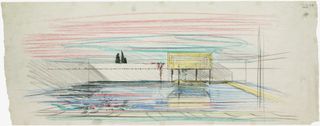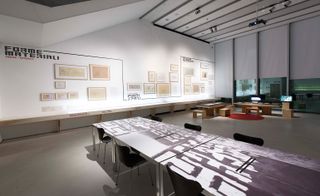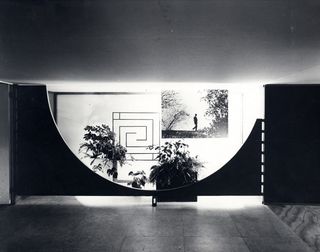Zen master: Carlo Scarpa and Japan's guiding influence

In 1978, Carlo Scarpa was visiting Sendai, in the north of Japan. It was only the Venetian architect’s second visit to the country, and it would be his last. Though the reason for his trip is unknown, his tragic death – after falling down a flight of stairs – has been widely recorded, perhaps because of the emphatic connection that it would make between Scarpa and Japan.
There are very clear Japanese influences in Scarpa’s most iconic achievements: features such as the interlocking circles (representing male/female union) at the Brion Cemetery, Veneto – where Scarpa is buried – the latticed Shoji-esque doors of the Castelvecchio Museum; the stark minimalism in his Olivetti showroom; the profound sensitivity to details to create harmony with the seasons. Scarpa established himself using old techniques and looking at ancient craft, by renewing tradition with modern innovation – qualities at the core of architectural thinking in post-war Japan.
Yet the influence of not only Japanese architecture, but of its culture, design and even Zen spiritualism in Scarpa’s work in Italy has been investigated very little (a 1996 documentary on the architect and designer, for example, makes no mention of Japan). Scarpa first visited Japan in 1969, yet for years before that was exposed to Japonism – the western fetishisation of Japanese culture and aesthetics – in the work of artists and architects he admired such as Gustav Klimt and Frank Lloyd Wright.

Original drawing of the water pavilion at Brion Tomb, San Vito d'Altivole, by Carlo Scarpa, 1969–1978
As part of the MAXXI Foundation’s exhibition 'The Japanese House. Architecture & Life after 1945' in Rome, the impact of Japan on his practice will be brought to light via Scarpa’s own personal documents, photographs and library, including the Japan Design House magazines he collected for a decade, as well as books on Japan by Fosco Maraini and Mario Gromo, used as travel guides and filled with Scarpa’s own reflections.
In an interview only a month before his final journey to the country in 1978, Scarpa said, 'Yes, I am very much influenced by Japan, and not just because I visited it, but because even before I went there, I admired their essentiality and above all their supreme good taste. What we call good taste is present everywhere in Japan.'
This rare exploration of Scarpa and Japan considers new ways for understanding one of the greatest architects of the 20th century and his legacy, and more widely, gives new insights into the history of significant cultural exchange between East and West in the last century.

This rare exploration of Scarpa and Japan considers new ways for understanding one of the greatest architects of the 20th century

The Brion Tomb, constructed between 1969–1978, is one of Scarpa's most elaborate creations.

Scarpa conceived the exhibition design for the Frank Lloyd Wright show (entrance pictured) at the MAXXI Foundation in 1960
INFORMATION
'Carlo Scarpa and Japan' is on view until 26 February 2017. For more information, visit the MAXXI Foundation website
ADDRESS
MAXXI Foundation
Via Guido Reni, 4/A
00196 Rome
Wallpaper* Newsletter
Receive our daily digest of inspiration, escapism and design stories from around the world direct to your inbox
Charlotte Jansen is a journalist and the author of two books on photography, Girl on Girl (2017) and Photography Now (2021). She is commissioning editor at Elephant magazine and has written on contemporary art and culture for The Guardian, the Financial Times, ELLE, the British Journal of Photography, Frieze and Artsy. Jansen is also presenter of Dior Talks podcast series, The Female Gaze.
-
 DAB 1α electric motorbike is the first product from French manufacturer DAB Motors
DAB 1α electric motorbike is the first product from French manufacturer DAB MotorsThe DAB 1α is an all-electric motorbike born out of industrial design, gaming culture and aviation technology, and now available to order
By Jonathan Bell Published
-
 The 2024 Ivor Novello nominations for songwriting have been revealed
The 2024 Ivor Novello nominations for songwriting have been revealed77 British and Irish songwriters and composers make up this year's nominees, announced tonight at London's Groucho Club
By Charlotte Gunn Published
-
 Why Bollinger’s La Grande Année 2015 champagne is worth celebrating
Why Bollinger’s La Grande Année 2015 champagne is worth celebratingChampagne Bollinger unveils La Grande Année 2015 and La Grande Année Rosé 2015, two outstanding cuvées from an exceptional year in wine-making
By Melina Keays Published
-
 Monospinal is a Japanese gaming company’s HQ inspired by its product’s world
Monospinal is a Japanese gaming company’s HQ inspired by its product’s worldA Japanese design studio fulfils its quest to take Monospinal, the Tokyo HQ of a video game developer, to the next level
By Ellie Stathaki Published
-
 Modern Japanese houses inspiring minimalism and avant-garde living
Modern Japanese houses inspiring minimalism and avant-garde livingWe tour the best Japanese architecture and modern Japanese houses designed by international and local architects that open up possibilities for all types of lifestyle, from minimalist to communal in Japanese architecture.
By Ellie Stathaki Published
-
 An Aoyama House exemplifies a synergetic architect and client relationship
An Aoyama House exemplifies a synergetic architect and client relationshipA client’s faith in his architect pays dividends in Aoyama House; a light-filled, effortlessly elegant Tokyo home
By Jens H Jensen Published
-
 Tokyo home Le49Ⅱ brings together drama, domestic luxury and hybrid working habits
Tokyo home Le49Ⅱ brings together drama, domestic luxury and hybrid working habitsLe49Ⅱ by Japanese architects Apollo is a Tokyo home for a young family with hybrid working habits
By Ellie Stathaki Published
-
 Takeshi Ikeuchi’s kei truck is a minimalist Japanese mobile showroom
Takeshi Ikeuchi’s kei truck is a minimalist Japanese mobile showroomTakeshi Ikeuchi's kei truck design is a Japanese timber specialist’s minimalist mobile showroom
By Jens H Jensen Published
-
 Nekoyacho Bldg is a Hiroshima office on a crossroads of 'food, work and entertainment'
Nekoyacho Bldg is a Hiroshima office on a crossroads of 'food, work and entertainment'Nekoyacho Bldg has been designed by Suppose Design Office as a 21st century workspace in Hiroshima, Japan
By Danielle Demetriou Published
-
 Heatherwick Studio’s Azabudai Hills district launches as Tokyo’s newest city-in-a-city
Heatherwick Studio’s Azabudai Hills district launches as Tokyo’s newest city-in-a-cityTokyo welcomes the Azabudai Hills district, designed by Heatherwick Studio and constructed as a city-in-a-city after over three decades of planning
By Danielle Demetriou Published
-
 Toranomon Hills Station by OMA adds dynamism to the Tokyo skyline
Toranomon Hills Station by OMA adds dynamism to the Tokyo skylineToranomon Hills Station is OMA's first tower in Tokyo - as well as a project expanding and evolving the high rise typology
By Danielle Demetriou Published